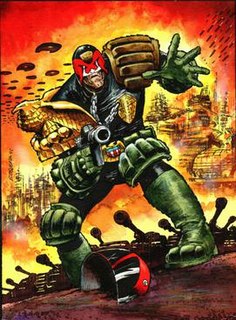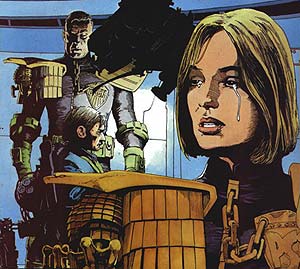Related Research Articles

Judge Joseph Dredd is a fictional character created by writer John Wagner and artist Carlos Ezquerra. He first appeared in the second issue of 2000 AD (1977), which is a British weekly anthology comic. He is the magazine's longest-running character. He also appears in a number of film and video game adaptations.

Judge Cassandra Anderson is a fictional law enforcer and psychic appearing in the British science fiction comics 2000 AD and the Judge Dredd Megazine. Created by writer John Wagner and artist Brian Bolland, Anderson made her debut as a supporting character in the Judge Dredd story "Judge Death". The character's popularity with readers led to her starring in her own series, Anderson: Psi-Division, which has been written almost exclusively by Alan Grant, often working with artist Arthur Ranson until 2005; Boo Cook drew a majority of the stories until 2012, since which a number of different artists have worked on the strip. In 2012 the character appeared in the film Dredd, played by Olivia Thirlby.

Mega-City One is a huge fictional post-nuclear megalopolis-size megacity city-state covering much of what is now the Eastern United States and some of Canada in the Judge Dredd comic book series and its spinoff series. The exact geography of the city depends on which writer and artist has done which story, but from its first appearance it has been associated with New York City's urban sprawl; originally it was presented as a future New York, which was retconned as the centre of a "Mega-City One" in the very next story.

The Angel Gang is a fictional group of villains appearing within the Judge Dredd comic strip in the weekly comic book 2000 AD. They are "a family of scruffy, backwoodsy, outrageously cruel thugs" from the Cursed Earth near Texas City who vie with the titular Dredd.

Chief Judge Barbara Hershey is a fictional character in the Judge Dredd series that appears in British comic 2000 AD. For nearly two decades she regularly appeared as Dredd's junior colleague, before being promoted to become his superior in 1999. She also had her own solo series, Judge Hershey, in the Judge Dredd Megazine (1992–1997).
Gordon Rennie is a Scottish comics writer, responsible for White Trash: Moronic Inferno, as well as several comic strips for 2000 AD and novels for Warhammer Fantasy.

Judge is a title held by several significant characters in Judge Dredd and other series which appear in the British comics 2000 AD and Judge Dredd Megazine. In the fictional future history of the series, the role of "Judge" combines those of judge, jury and police officer, thus avoiding long legal wrangles by allowing for criminals to be tried and sentenced on the spot. Since they overthrew the U.S. Constitution in 2070, Judges have also held supreme political power in Mega-City One. Collectively they are known as the Justice Department.

Devlin Waugh is a fictional character who has appeared regularly in British comic anthologies 2000 AD and Judge Dredd Megazine. The character, a homosexual vampire, was originally created by the writer-artist team John Smith and Sean Phillips in 1992.
Robbie Morrison is a British comics writer most known for his work in the weekly UK title 2000 AD, and as the co-creator of popular character and series Nikolai Dante, serialised for 15 years until 2012.
Siku is the pseudonym of British/Nigerian artist and writer Ajibayo Akinsiku, best known for his work in 2000 AD.

Chief Judge of Mega-City One is the title of several supporting characters in the Judge Dredd comic strip published in 2000 AD. The chief judge is dictator and head of state of Mega-City One, a fictional future city of around 400 million people in 22nd-century America. The present chief judge is Judge Logan.

Chief Judge Hadrian Volt is a fictional character appearing in the Judge Dredd comic strip, published by British anthology 2000 AD. He was chief judge of Mega-City One between 2116 and 2121.
Harlem Heroes is a British comic strip that formed part of the original line-up of stories in 2000 AD. Inspired by the popularity during the 1970s of kung fu films and the Harlem Globetrotters, Harlem Heroes was devised by Pat Mills, employing elements from his Hellball comic strip, and scripted by Tom Tully. Initially, the series was to have been drawn by Carlos Trigo but the Spanish artist was replaced by Dave Gibbons prior to the first issue's publication. From issue 25 Massimo Belardinelli drew the concluding episodes of the first series and would be retained as its regular artist for the strip's reinvention as Inferno.

Judge Grice was a fictional character in the Judge Dredd comic strip in 2000 AD. Created in 1990 by John Wagner and Steve Dillon, Grice later had his own spin-off series, Purgatory (1993) by Mark Millar and Carlos Ezquerra. Originally a minor supporting character and one of Dredd's colleagues, he later became a notable villain, at first with good intentions, but later he descended into psychosis and became truly evil. In the Judge Dredd story "Inferno" (1993) he seized control of Mega-City One and proclaimed himself chief judge.

2000 AD crossovers are crossover stories appearing in British comic 2000 AD, its sister title the Judge Dredd Megazine, and other related output, such as novels, audio plays, films and role-playing games.

Judge Giant can refer to either of two fictional characters appearing in the Judge Dredd comic strip in 2000 AD. They are father and son. Their first names have never been given.
Psi-Judge Karyn is a fictional character from the Judge Dredd comic strip in British comic 2000 AD. Along with Judge Janus, she was an attempted replacement for Judge Anderson who had left Justice Department in 1993. John Freeman wrote most of her solo stories and in 2014 said his last few "are pretty dire, to be frank"; the first Karyn solo strip had not been written for Adrian Salmon but the second was written "knowing his strengths". When Anderson returned in 1995, Karyn disappeared from the strip except for the story "Judge Dredd: Fetish" in 1997: writer John Smith has stated this was originally written as Anderson but "in the end I wasn’t allowed to use her because she was off in outer space so we just substituted Karyn instead". He said in the same interview that he felt it lacked the same emotional weight with Karyn in danger.

This is a list of works by Scottish author Alan Grant.
Megacities in the Judge Dredd comics are a fictional exaggeration of the real megacity concept: instead of just being a large conurbation, they cover most of their original country and have replaced nations as the dominant political entity. The most commonly seen megacity is Mega-City One. In the strip, these cities are all that remains of their original countries after the Atomic Wars of 2070, and are mostly dictatorships run by the Judges.
"Trifecta" is a Judge Dredd story arc published in British comic 2000 AD in late 2012, following on from the earlier strip Day of Chaos. The story was an unannounced crossover between Judge Dredd and its spinoff strips The Simping Detective and Low Life.
References
- ↑ The A-Z Of Judge Dredd, Hamlyn 1995
- ↑ Megazine Pan-Africa map, reprinted at
- ↑ Megazine 3.06-13: "Pan-African Judges: Fever of the Gods"
- ↑ Megazine 3.26 to 3.30: "Judge Dredd: Fetish"
- ↑ Progs 859-866: "Judge Dredd: Book of the Dead"
- ↑ prog 1017: "Judge Dredd: Darkside" Part 1
- ↑ Prog 701. Archived at 2000 AD Database
- ↑ Megazine Pan-Africa map, reprinted at
- ↑ Fetish, Megazine 3.26-30
- ↑ Judge Dredd: Eclipse by James Swallow
- ↑ Progs 859 to 866: "Judge Dredd: Book of the Dead"
- ↑ Judge Dredd: The Hundredfold Problem by John Grant
- ↑ Judge Dredd: Wetworks
- ↑ Prog 1017
- ↑ Eclipse Glossary section
- ↑ Devlin Waugh: Plague of Frogs Progs 1158 to 1167
- ↑ Megazine 3.06-13: "Pan-African Judges: Fever of the Gods"
- ↑ Megazine 2.37-46
- ↑ Judge Dredd: Silencer